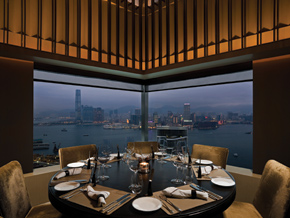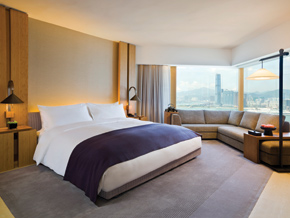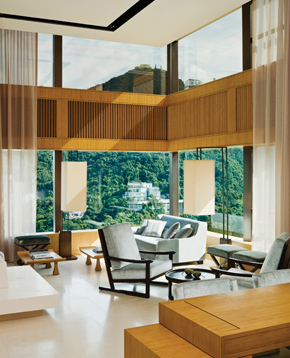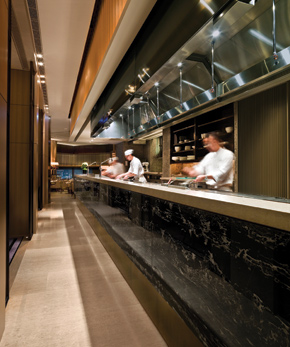|
 The semi-private dining area
overlooks Victoria Harbour.
The semi-private dining area
overlooks Victoria Harbour.
Arriving at the Upper House it is hard not to feel sorry for
taxi
drivers. Despite being located at Pacific Place, one of Hong
Kong’s most prominent addresses, the hotel itself is so
carefully
tucked away that you could easily miss it. A subtle stylised
‘UH’ logo is all
that announces the place to passers-by.
Slipping through a Thomas Heatherwicke-designed stone curtain
and into the building there is an immediate sense of calm and
comfort.
Check-in is handled online so there’s no desk, only the
sight of the
hotel’s welcoming team decked out in their crisp but casual
outfits.
Housed in a 49-storey building, the hotel is split between
a landing area and the rooms, which start on the 38th floor.

The rooms are the largest in
the crowded city.
Whisked up in a lift, guests
are lofted out of the city and into the world of the Upper House.
Wedged in between the busy Wan Chai and Central districts,
the
Upper House is the perfect base for exploring the city as it
settles into
its 21st century role.
Old city, new facilities
While Beijing and Shanghai boom, Hong Kong has the relaxed
self-confidence of a well-established metropolis.
There is new money, as the towers of the International Finance
Centre and International Commerce Centre facing off across the
harbour indicate, but the Jockey Club and British street names
are reminders of its imperial past. That blend of vitality and
refinement lures the more stylish Chinese south to mix with
Western expats and visitors, and to shop and enjoy themselves.
The easy-going sensibility is evident in the 49th-floor Upper
House bar, where groups of people pack out the window-side booths
and peer down on the city below, chattering in Chinese, English
and French.
|
 |
On weekends, it is packed all night, and even Sunday draws
a good crowd hoping to stave off the working week a little longer.
The only disadvantage of drinking all the way up there is it
makes popping out for a cigarette a bit difficult, but it does
mean a chance to venture down to the sixth-floor terrace garden.
By morning, ash trays have been cleared away for weekend yoga
classes, and, while the outside room is a luxury in Hong Kong,
it’s a shame the ‘grass’ is artificial.
Preferring to avoid any early morning bending and stretching,
families gather for breakfast in Café Gray Deluxe to
prepare for the heat of the day and plan, with military precision,
exactly how they will unload their wallets in the Pacific Place
mall. In the evenings, they are replaced by couples seeking
the intimacy of the restaurant.
| ‘There is an immediate sense of
calm and comfort.’ |
Gray Kunz’s menu features his signature short beef ribs
matched with Asian and European dishes. The dishes mirror the
hotel itself: immaculately presented but not fancy or intimidating.
Key players
Veteran general manager Dean Winter traded England for Hong
Kong,
where he now lives with his family, and has been deeply involved
in the
project from its conception. The design and remodelling project
was
handed to Hong Kong-born rising star Andre Fu.
At just 31, when he received the commission, Fu spent four
years bringing his vision for the hotel to life, tackling the
challenge of creating an inviting intimate space inside a skyscraper.
He describes the project as a ‘poetic upward journey’
from entrance to the crowning halo, suspended over the sky bridge
across the atrium and into Café Gray. Meanwhile, 120ft
below the bridge, a pool casts reflections up the wall, mingling
with Hiroshiwata Sawada’s steel lattice sculpture Rise,
and uniting the vertical space.
Unique touches
With 117 rooms, the Upper House is not exactly boutique but
it has a very different feel to the giant business hotels that
otherwise dominate the city’s luxury scene.
Working on a relatively small scale, the team has focused on
quality and detail. Oak and bamboo are matched against Italian
Bedonia stone; clean crisp lines are softened by hazy lighting.
Art features throughout the public and private spaces: Marvin
Mintofang’s heavy stone sculptures duel with Choi Tae Hoon’s
wiry steel creations.
The rooms themselves are the largest in the crowded city –
even the smallest would pass for a suite at many other hotels
on the island, and are divided almost equally between living
space and bathroom.
The most striking features are the views across downtown Hong
Kong, and the large windows give the feeling you could just
stride out across the rooftops. The downside is that when the
curtains are drawn the rooms suddenly lose some of their charm.
|
 |

The design team focused on
quality and detail.
That disappointment aside, there is an incredible attention
to detail in the design. Drawers, for example, are glass fronted
to stop guests forgetting things.
A holdall is stashed at the bottom of the wardrobe to lug away
souvenirs; made of parachute fabric, it is strong enough to
be checked in on the way home.

Clean crisp lines meet
soft hazy lighting.
Customised iPod Touches give access to information about the
surrounding area and can be used to order room service. The
hotel plays on the distinction between public and private space.
While the rooms were conceived as floating sanctuaries, the
bar and restaurant were designed to draw in anyone, explains
managing director Brian Williams, except bored business travellers.
|











